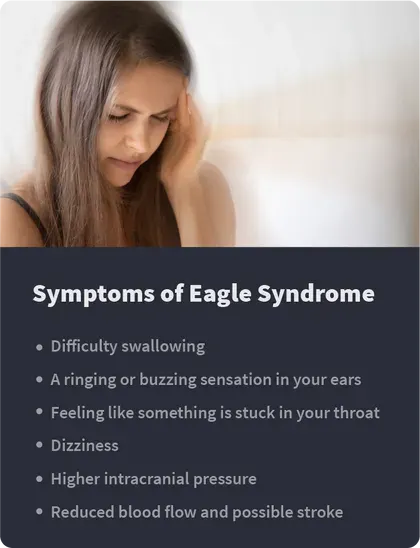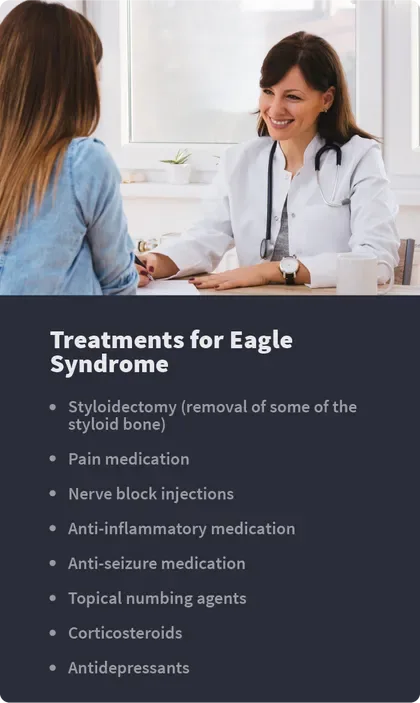Eagle Syndrome: Everything You Need to Know

Table of Contents
- Symptoms
- Causes
- Diagnosis
- Treatment
- Complications
- Success Rates
- References
Eagle syndrome (also sometimes called Eagle's syndrome or stylohyoid syndrome) is an uncommon medical condition caused by problems with specific bones and ligaments in the neck. If those problems affect the carotid artery, the sufferer may develop the vascular variant of Eagle syndrome.
Pain, swallowing difficulties, and other problems it causes can have a significant impact on a person's quality of life.
The condition is estimated to affect four to eight out of every 10,000 people, and it was first described by American otorhinolaryngologist (ear, nose, and throat specialist, or ENT) Watt Weems Eagle in 1937.
It can also raise their risk of a stroke or carotid artery dissection. This condition can often be cured with surgery or managed with a variety of medications.
Symptoms of Eagle Syndrome
The most common symptom of Eagle syndrome is recurring pain in one side of the throat and face. In some cases, pain may be felt on both sides. It is sharp and may be triggered by swallowing, moving the jaw or neck, or by yawning or coughing.

Some other common symptoms of Eagle syndrome include:
Difficulty swallowing
A ringing or buzzing sensation in your ears
Feeling like something is stuck in your throat
There is also an additional variant version of Eagle syndrome called vascular Eagle syndrome. This version of the condition has a few additional symptoms, including:
Dizziness
Higher intracranial pressure
Reduced blood flow and possible stroke
Causes

Eagle Syndrome is caused by either an abnormally long styloid process (a small bone located just under the ear) or a calcified stylohyoid ligament (a neck ligament that has become thick and inflexible due to calcium buildup).
Vascular Eagle syndrome is a variant of standard Eagle syndrome. It occurs when these bone and ligament problems create abnormal pressure on the carotid artery (the thick main artery inside your neck). When this happens, the artery becomes compressed, and the surrounding area can become inflamed.
Scientists do not currently know what causes either of these underlying issues. However, they do know that people who have these physical features do not necessarily also have Eagle syndrome. While about 4 percent of the population has an elongated styloid process, not all of these people develop Eagle syndrome.
Women ages 30 to 60 are slightly more likely to develop Eagle syndrome. People with African heritage are also slightly more likely to be affected. These findings suggest that genetics may play a critical role in the development of this disease, but this is not confirmed.
Physical trauma also seems to play a role. More research is needed to identify the exact causes of Eagle syndrome.
Diagnosing Eagle Syndrome
Your doctor or dentist can screen for Eagle syndrome by feeling around the neck and in the back of the throat. If you have an unusually long styloid process, it will usually be easy to spot this way. X-rays will then be ordered to confirm the diagnosis.
Vascular Eagle Syndrome is usually a bit more difficult to identify. In cases when this version of the condition is suspected, doctors may order a CT scan with 3D reconstruction. This allows them to get a better look at how the structures in the patient's head and neck interact with each other and determine if anything is in contact with the carotid artery.
Treatment

Eagle syndrome is usually treated with a styloidectomy (removal of some of the styloid bone) to correct the size of the styloid process. Surgery typically cures all symptoms of Eagle syndrome. It is the preferred course of treatment and the only way to lower the chances of stroke or carotid artery dissection.
If surgery is not an option, the symptoms of Eagle syndrome can also be managed with medications. Depending on your needs, your doctor might prescribe one or more of the following medications:
Pain medication
Nerve block injections
Anti-inflammatory medication
Anti-seizure medication
Topical numbing agents
Corticosteroids
Antidepressants
Medication keeps the symptoms of Eagle syndrome under control and minimizes their impact on the patient’s life. It is often an effective treatment, but it does not correct the anatomical differences that cause the person’s Eagle syndrome in the first place. This means that the affected person may still be at a higher risk for stroke than the average person. Ideally, patients who choose this course of treatment will eventually receive surgery to correct the issue permanently.
Complications
People with Eagle syndrome may suffer from lasting pain that impacts their quality of life. They may find it difficult to enjoy food, speak for long periods of time or hold their head upright comfortably. Dealing with this type of chronic pain every day can lead to depression and other psychological issues.
Depending on how the bones and tissues in their neck interact, people with Eagle syndrome may also be at a higher risk for strokes and carotid artery dissection (tears in the artery). Since the symptoms of carotid artery dissection look a lot like the symptoms of a stroke, either problem is considered a health emergency and requires immediate treatment.
Treatment Success Rates
Approximately 80 percent of people who receive either surgery or medication for Eagle syndrome respond well to their treatment. Those who do respond well to medication still often go on to have their styloid process surgically corrected eventually.
After surgery, most patients never experience any more symptoms. However, it is possible for the styloid process to regrow after a styloidectomy. If you have had your Eagle syndrome surgically corrected and begin to experience pain and other symptoms again, be sure to mention this to your doctor or dentist. You may need a second surgery to correct the problem.
